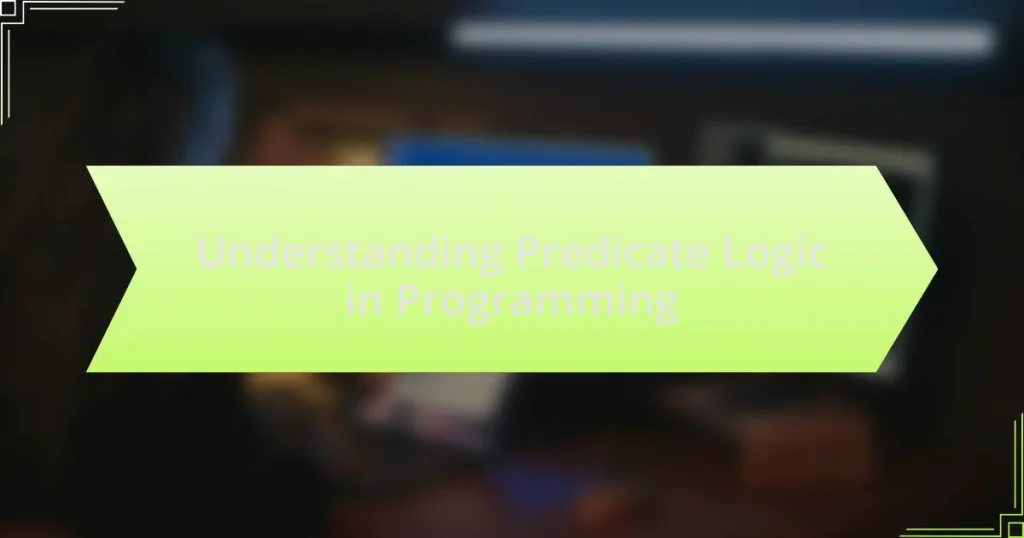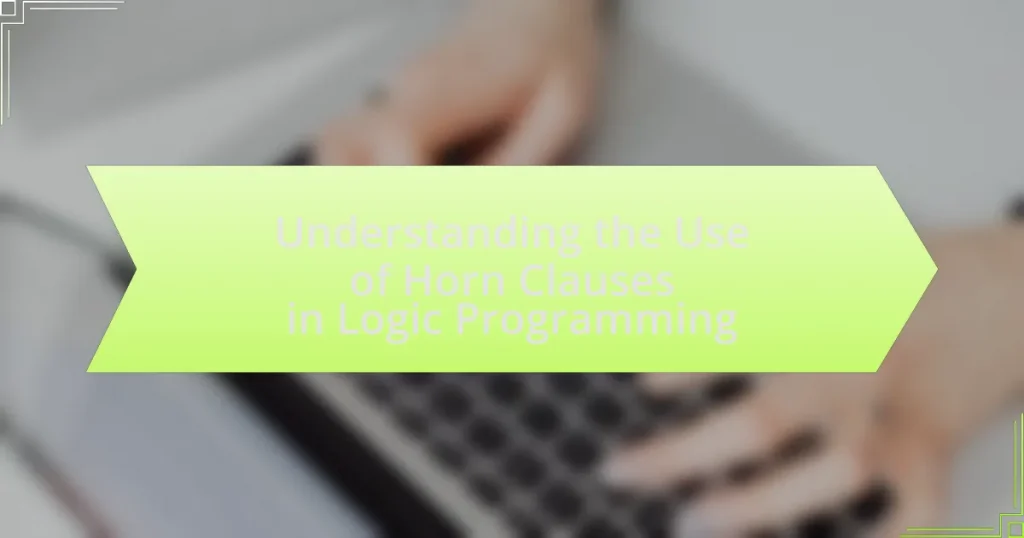Unification is a critical process in logic programming that enables the matching of logical expressions through variable substitution, facilitating query resolution and logical inference. This article explores the functioning of unification, its key principles, and its importance in languages like Prolog, where it supports efficient problem-solving and knowledge representation. It also examines different types of unification, including syntactic and semantic unification, and discusses the challenges and strategies associated with the unification process. Additionally, the article highlights best practices for optimizing unification in logic programs and the tools available to assist with these tasks.

What is the Role of Unification in Logic Programming?
Unification in logic programming is a fundamental process that determines how different logical expressions can be made identical by finding a suitable substitution for their variables. This process is essential for enabling the resolution of queries against a knowledge base, as it allows the matching of predicates and the application of rules. For instance, in Prolog, unification is used to bind variables in a query to values in the database, facilitating the retrieval of relevant information. The correctness of unification is supported by its ability to handle various forms of expressions, ensuring that logical consistency is maintained throughout the programming process.
How does unification function within logic programming?
Unification in logic programming functions as a process that determines how two logical expressions can be made identical by finding a substitution for their variables. This process is essential for enabling the resolution of queries against a knowledge base, as it allows for the matching of predicates and terms within logical statements. For instance, in Prolog, unification is used to bind variables to values or other variables, facilitating the execution of rules and queries. The correctness of unification is supported by its foundational role in algorithms like the resolution principle, which relies on the ability to unify clauses to derive conclusions from a set of premises.
What are the key principles of unification?
The key principles of unification in logic programming include the process of making two terms identical by finding a substitution for their variables. This principle is foundational in automated reasoning and logic programming, as it allows for the resolution of queries against a knowledge base. Unification operates under specific rules, such as the requirement that variables can be replaced with terms, and that the same variable must be consistently replaced throughout the expression. For example, in Prolog, unification is used to match predicates and facilitate the execution of logical queries, demonstrating its critical role in the functioning of logic programming systems.
How does unification differ from other programming concepts?
Unification is a specific process in logic programming that differs from other programming concepts by focusing on making two terms identical through variable substitution. Unlike traditional programming paradigms that emphasize control flow and state changes, unification operates on the principle of matching structures and resolving variables to achieve consistency in logical expressions. This is foundational in languages like Prolog, where unification enables pattern matching and inference, allowing for the execution of queries against a knowledge base. The distinctiveness of unification lies in its declarative nature, contrasting with imperative programming, which requires explicit instructions for computation.
Why is unification important in logic programming?
Unification is important in logic programming because it enables the matching of terms and the resolution of variables within logical expressions. This process allows for the derivation of conclusions from premises by systematically substituting variables with concrete values, facilitating the execution of queries and the implementation of rules. For instance, in Prolog, unification is the mechanism that allows the interpreter to determine whether a given goal can be satisfied by the available facts and rules, thereby driving the inference process.
What advantages does unification provide for logical reasoning?
Unification enhances logical reasoning by enabling the matching of terms and structures within logical expressions, facilitating the derivation of conclusions from premises. This process allows for the resolution of variables, making it possible to infer relationships and derive new knowledge from existing information. For instance, in Prolog, unification is a core mechanism that allows the system to determine if two terms can be made identical, thus supporting efficient query resolution and knowledge representation. The ability to systematically replace variables with concrete values streamlines the reasoning process, leading to more effective problem-solving in logic programming contexts.
How does unification enhance problem-solving capabilities?
Unification enhances problem-solving capabilities by allowing disparate logical expressions to be transformed into a common form, facilitating the resolution of queries in logic programming. This process enables the identification of variable substitutions that make different predicates compatible, thereby streamlining the inference process. For instance, in Prolog, unification is a core mechanism that allows the system to match goals with rules and facts, leading to efficient query resolution and knowledge extraction. The effectiveness of unification is evidenced by its foundational role in logic programming languages, where it directly contributes to the ability to derive conclusions from a set of premises, thus improving the overall problem-solving efficiency.

What are the types of unification in logic programming?
The types of unification in logic programming include syntactic unification, semantic unification, and higher-order unification. Syntactic unification focuses on matching terms based on their structure and symbols, ensuring that variables can be replaced consistently to make expressions identical. Semantic unification, on the other hand, involves matching terms based on their meanings or interpretations, which may require additional context or knowledge about the domain. Higher-order unification extends the concept to include functions and predicates that can take other functions as arguments, making it more complex and less decidable than first-order unification. These distinctions are crucial for understanding how logic programming systems resolve queries and perform reasoning tasks effectively.
What are the different forms of unification?
The different forms of unification in logic programming include syntactic unification, semantic unification, and type unification. Syntactic unification involves matching terms based on their structure and symbols, ensuring that variables can be replaced consistently to make expressions identical. Semantic unification focuses on the meanings of terms, ensuring that the interpretations align within a given context. Type unification deals with ensuring that types of expressions are compatible, often used in type systems to infer types for variables and functions. Each form plays a crucial role in the functioning of logic programming languages, facilitating the resolution of queries and the execution of programs.
How do first-order unification and higher-order unification differ?
First-order unification and higher-order unification differ primarily in their expressive power and the types of variables they can handle. First-order unification deals with predicates and terms that do not allow for functions as arguments, while higher-order unification permits variables to represent functions and predicates themselves, enabling a richer structure in logical expressions.
In first-order logic, unification involves finding substitutions for variables that make different terms identical, which is computationally decidable. In contrast, higher-order unification is generally undecidable due to the complexity introduced by allowing function variables, making it significantly more challenging to determine unifiers. This distinction is crucial in logic programming, as it affects the types of problems that can be solved and the efficiency of the unification process.
What are the implications of each type of unification?
The implications of each type of unification in logic programming include varying degrees of computational complexity and expressiveness. First, syntactic unification, which matches terms based on their structure, allows for straightforward variable binding but can lead to inefficiencies in terms of time complexity, particularly in cases of non-linear terms. Second, semantic unification, which considers the meanings of terms, enhances expressiveness by enabling more sophisticated reasoning about the relationships between entities, but it often requires more complex algorithms and can increase the computational overhead. Lastly, type unification, which ensures that terms conform to specific data types, can prevent runtime errors and improve program reliability, yet it may restrict flexibility in term usage. Each type of unification thus has distinct implications for performance, expressiveness, and reliability in logic programming contexts.
How does unification relate to other concepts in logic programming?
Unification is a fundamental process in logic programming that relates to concepts such as resolution, backtracking, and predicate logic. It serves as a mechanism for making two terms identical by finding a substitution for their variables, which is essential for resolving queries against a knowledge base. For instance, in Prolog, unification allows the system to match goals with rules and facts, enabling the derivation of conclusions. This process is tightly linked to resolution, as unification is used to determine whether a clause can be resolved with another clause, thereby facilitating logical inference. Additionally, unification plays a critical role in backtracking algorithms, where it helps in exploring different possibilities by reverting to previous states when a contradiction is encountered. Thus, unification is integral to the functioning of logic programming, underpinning key operations that drive inference and problem-solving.
What is the connection between unification and resolution?
Unification and resolution are interconnected processes in logic programming that facilitate automated theorem proving. Unification is the process of making two logical expressions identical by finding a substitution for their variables, while resolution is a rule of inference that derives a conclusion from two clauses containing complementary literals. The connection lies in the fact that unification is often a prerequisite for resolution; specifically, resolution requires unification to combine clauses effectively. For example, in propositional logic, when resolving two clauses, the unification of their literals allows for the derivation of new clauses, thereby advancing the proof process. This relationship underscores the importance of unification in enabling resolution to function correctly within logic programming frameworks.
How does unification interact with backtracking in logic programming?
Unification in logic programming is a process that determines if two terms can be made identical by substituting variables with constants or other variables. This process interacts with backtracking by providing a mechanism to explore different possible substitutions when a goal cannot be satisfied with the current bindings. When a unification attempt fails, backtracking allows the logic programming system to revert to the previous state and try alternative substitutions, effectively enabling the exploration of multiple paths in the search space. This interaction is crucial for finding solutions in non-deterministic environments, as it allows the system to systematically explore all potential matches and resolve conflicts that arise during the unification process.

What are the challenges associated with unification in logic programming?
The challenges associated with unification in logic programming include dealing with variable binding, handling infinite terms, and managing the complexity of unification algorithms. Variable binding can lead to ambiguities when multiple variables are involved, making it difficult to determine the correct substitutions. Infinite terms pose a significant challenge as they can result in non-terminating unification processes, complicating the implementation of logic programming systems. Additionally, the complexity of unification algorithms can increase exponentially with the size of the terms being unified, leading to performance issues in practical applications. These challenges highlight the need for efficient algorithms and strategies to ensure effective unification in logic programming contexts.
What common issues arise during the unification process?
Common issues that arise during the unification process in logic programming include variable binding conflicts, non-unifiable terms, and inefficiencies in search algorithms. Variable binding conflicts occur when a variable is assigned multiple values, leading to inconsistencies. Non-unifiable terms arise when two terms cannot be made identical through any substitutions, which can halt the unification process. Additionally, inefficiencies in search algorithms can lead to excessive computational time, particularly in complex queries or large datasets, as demonstrated in studies on unification algorithms that highlight performance bottlenecks.
How can ambiguities affect unification outcomes?
Ambiguities can significantly hinder unification outcomes by introducing multiple interpretations of terms or predicates, leading to inconsistent results. In logic programming, unification relies on the precise matching of terms; when ambiguities arise, such as in the case of overloaded predicates or vague variable definitions, the system may struggle to find a single, coherent solution. For instance, if a predicate can represent different functions based on context, the unification process may yield conflicting bindings, ultimately resulting in failure to derive a valid conclusion. This phenomenon is well-documented in computational logic, where studies have shown that ambiguous inputs can lead to exponential increases in computational complexity, thereby affecting the efficiency and reliability of logic-based systems.
What strategies can be employed to resolve unification conflicts?
To resolve unification conflicts, strategies such as constraint satisfaction, backtracking, and the use of unification algorithms can be employed. Constraint satisfaction involves defining constraints that must be met for unification to succeed, allowing for a systematic approach to identify and resolve conflicts. Backtracking is a method where the system revisits previous decisions to explore alternative paths when a conflict arises, effectively allowing for the correction of errors in the unification process. Additionally, unification algorithms, like the Robinson’s unification algorithm, provide a formalized method for determining whether two terms can be unified and can help identify conflicts by analyzing the structure of the terms involved. These strategies are validated by their application in various logic programming environments, demonstrating their effectiveness in managing unification conflicts.
What best practices can be followed for effective unification?
Effective unification in logic programming can be achieved by following best practices such as ensuring variable consistency, utilizing efficient algorithms, and minimizing redundancy. Variable consistency involves maintaining a clear distinction between free and bound variables to avoid conflicts during the unification process. Efficient algorithms, like the Robinson’s unification algorithm, enhance performance by systematically resolving variable bindings. Minimizing redundancy, such as avoiding unnecessary computations or duplicate variable bindings, streamlines the unification process and improves overall efficiency. These practices are supported by the foundational principles of logic programming, which emphasize the importance of precise variable management and algorithmic efficiency in achieving successful unification outcomes.
How can programmers optimize unification in their logic programs?
Programmers can optimize unification in their logic programs by implementing strategies such as using efficient data structures, minimizing the search space, and employing heuristics. Efficient data structures, like disjoint-set forests, can speed up the process of finding and merging variable bindings. Minimizing the search space involves reducing the number of potential unifications by applying constraints early in the process, which can significantly decrease the computational overhead. Heuristics, such as selecting the most constrained variable first, can lead to quicker resolutions by prioritizing the most limiting conditions. These methods collectively enhance the performance of unification, making logic programs more efficient and responsive.
What tools are available to assist with unification tasks?
Tools available to assist with unification tasks include Prolog, which is a logic programming language specifically designed for tasks involving unification. Prolog’s built-in unification algorithm allows for efficient variable binding and pattern matching, essential for logical inference. Additionally, libraries such as SWI-Prolog and GNU Prolog provide enhanced functionalities for unification tasks, including support for constraint logic programming. These tools are widely used in artificial intelligence and computational linguistics, demonstrating their effectiveness in handling unification in logic programming contexts.



